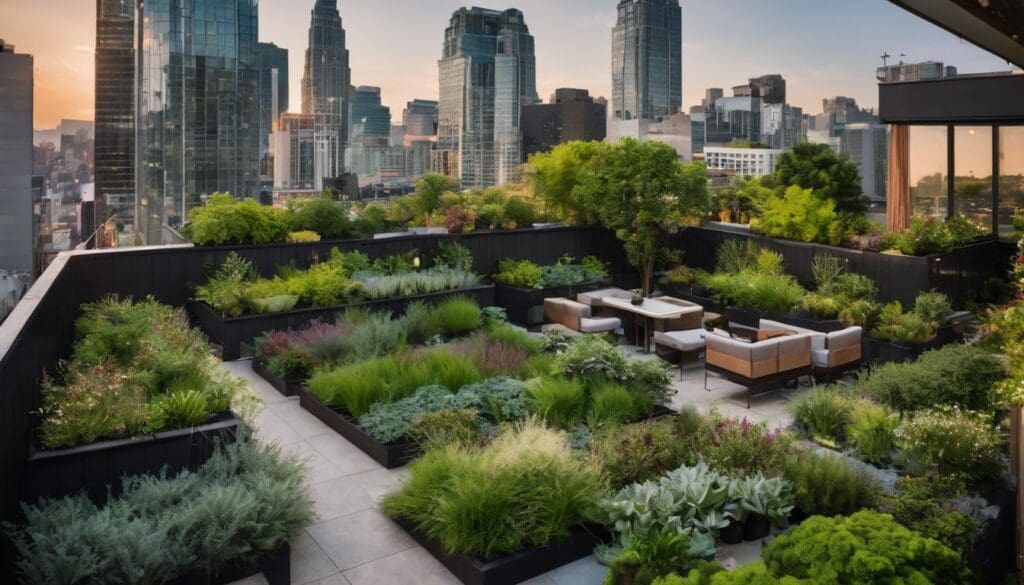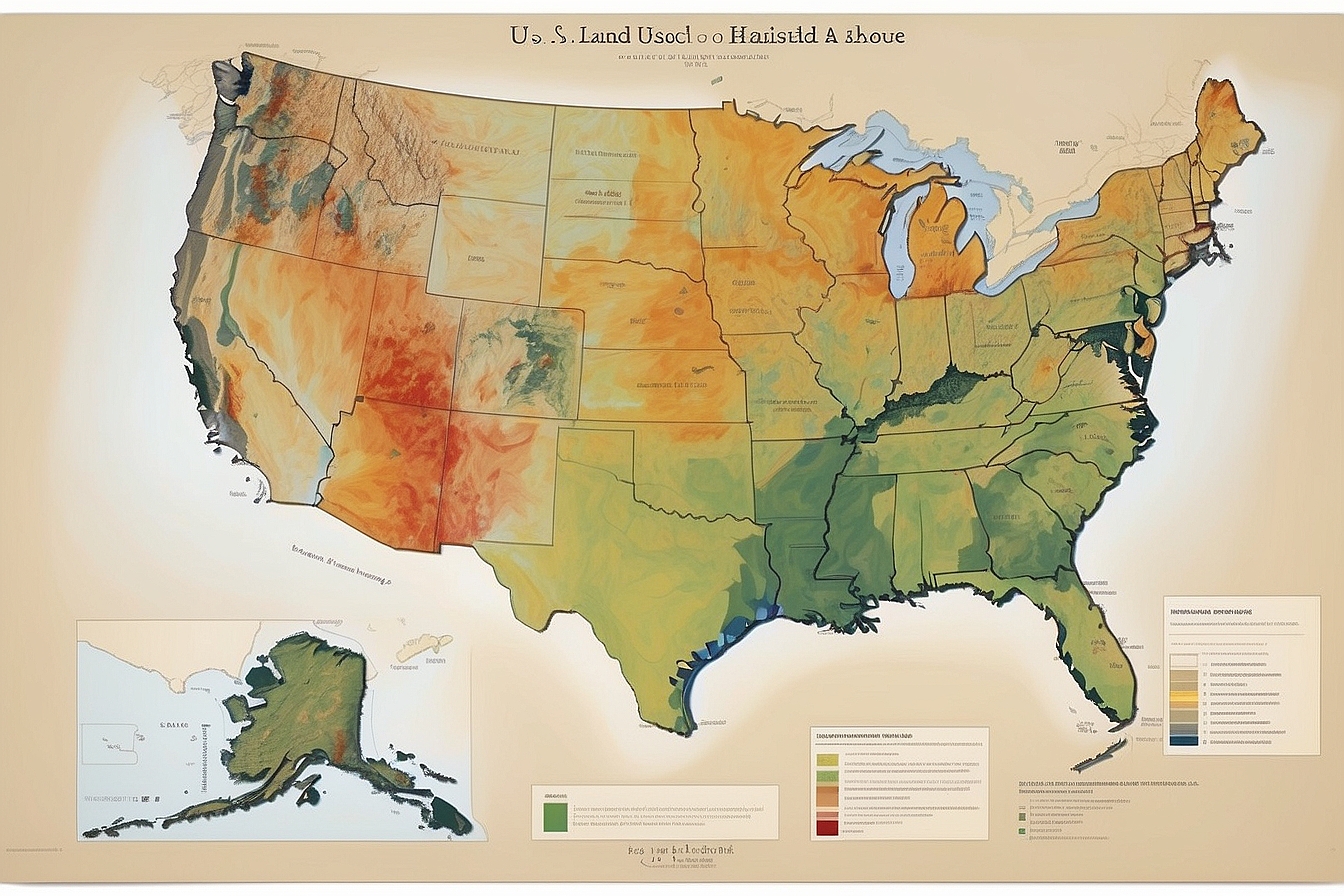As our cities blossom into ever-growing metropolises, many of us feel the oppressive heat that seems to cling stubbornly between buildings and pavements. That unwelcome warmth is not just a mere annoyance – it whispers to us of a more profound environmental quandary.
In this article, we delve into the role that land plays in nurturing these ‘Urban Heat Islands’, casting light on methods to mitigate the stifling embrace of our built environments.
Stick with us as we explore innovative solutions that promise to reintroduce a breath of fresh air into the hustle and bustle of urban life.
Key Takeaways
- Urban Heat Islands, or UHIs, are significantly warmer urban areas compared to surrounding rural places due to city developments like buildings and roads which absorb the sun’s heat.
- Different land cover types affect city temperatures – vegetation and water bodies cool the environment while built-up areas and impervious surfaces contribute to higher urban temperatures.
- Implementing strategies such as increasing green spaces, using reflective materials for roofs and pavements, promoting sustainable design, enhancing water bodies, developing green infrastructure, adopting smart technologies, and encouraging community initiatives can help reduce the UHI effect.
- Real-world examples include Tokyo’s use of green roofs and walls to lower heat absorption by buildings, Singapore’s creation of more green spaces, and Barcelona’s Superblock project that prioritises pedestrian-friendly zones with increased greenery. These efforts have successfully reduced urban temperatures in these cities.
- The case studies emphasise that proactive planning is key in combatting Urban Heat Island effects for creating cooler city environments.
Understanding Urban Heat Islands
Urban Heat Islands are urban areas that experience significantly higher temperatures than their surrounding rural areas. This is caused by human activities such as the construction of buildings and roads, which replace natural land cover with built-up surfaces.
Definition
Urban Heat Islands (UHIs) occur when cities experience higher temperatures than their rural surroundings. This happens because urbanisation leads to changes in the land use and landscape.
Buildings, roads, and other infrastructure absorb and re-emit the sun’s heat more than natural landscapes such as forests and water bodies.
Our communities face this effect because of the way we have designed them. As we construct more built-up surfaces, they replace the natural land cover which normally cools down through water evaporation from soil and transpiration from plants.
These artificial surfaces also retain heat longer, causing our city environments to become warmer than areas with less development. Addressing UHIs is crucial in urban planning if we aim to reduce heat stress among city dwellers while minimising environmental impact.
Causes
Urban Heat Islands are caused by various factors, including:
- Increased solar radiation absorption due to built-up surfaces.
- Changes in urban form and city development.
- Higher surface temperatures resulting from urban infrastructure.
- Reduced green spaces and vegetation cover.
Impact of Land Use on Urban Heat Islands
Land cover types, such as built-up surfaces, play a significant role in the formation of urban heat islands. Understanding how different land use patterns contribute to the UHI effect is crucial in implementing effective mitigation strategies.
Case studies of successful efforts to reduce the impact of land use on urban heat islands can offer valuable insights for sustainable city planning.
Land Cover Types
Our cities’ landscapes are a patchwork of various land cover types, each playing a role in the urban heat island effect. Below is a table summarising the different types of land cover and their impact on urban temperatures:
table {
font-family: Arial, sans-serif;
border-collapse: collapse;
width: 100%;
}
th, td {
border: 1px solid #dddddd;
text-align: left;
padding: 8px;
}
th {
background-color: #f2f2f2;
}
Land Cover Types and Their Impact on Urban Heat Islands
| Land Cover Type | Characteristics | Impact on Urban Heat Island |
|---|---|---|
| Vegetation | Trees and plants. | Reduces heat through shade and evapotranspiration. |
| Water Bodies | Lakes, rivers, and ponds. | Provides cooling through evaporation. |
| Bare Soil | Exposed earth without vegetation. | Can be hot during the day, cooler at night. |
| Built-up Areas | Buildings, roads, and other infrastructures. | Absorbs and retains heat, contributing to higher temperatures. |
| Green Spaces | Parks, gardens, and recreational areas. | Helps to mitigate heat, similar to vegetation. |
| Impervious Surfaces | Concrete, asphalt, and other non-porous materials. | Increases heat storage and radiates heat back into the atmosphere. |
By understanding these categories, we can tailor our strategies to minimise the urban heat island effect. Green roofs, for instance, turn impervious surfaces into spaces that can support vegetation. We know incorporating more natural elements into the urban environment is key to cooling our cities. Working together, we can transform our urban landscapes for the better.
Strategies for Reducing UHI Effect
As environmental advocates, we understand the importance of mitigating urban heat islands (UHIs) and their impact on our cities. Here are some effective strategies for reducing the UHI effect:
- Increasing green spaces: Planting trees and creating urban parks can help lower surface temperatures and provide shade to reduce the UHI effect.
- Implementing cool roofs and pavements: Using reflective materials for roofs and pavements can decrease the absorption of solar radiation, thus lowering surface temperatures in urban areas.
- Promoting sustainable urban design: Encouraging compact, mixed-use developments with proper ventilation and energy-efficient buildings can reduce heat retention in cities.
- Enhancing water bodies: Incorporating water features such as ponds, lakes, and fountains can cool down urban environments through evaporative cooling.
- Developing green infrastructure: Installing green roofs, green walls, and permeable surfaces can help absorb heat and improve air quality in urban areas.
- Adopting smart city technologies: Utilising advanced technologies for monitoring and controlling energy use, transportation systems, and building operations can contribute to reducing the UHI effect.
- Supporting community-based initiatives: Encouraging local communities to participate in tree-planting programs, creating community gardens, and advocating for sustainable practices can have a positive impact on mitigating UHIs.
Case Studies of Mitigation Efforts
Cities around the world have implemented various strategies to mitigate the urban heat island (UHI) effect. For example, in Tokyo, green roofs and walls have been integrated into building designs to increase vegetation cover and reduce heat absorption by built-up surfaces.
This has helped lower surface temperatures and improve air quality. Similarly, in Singapore, initiatives such as creating more green spaces and incorporating reflective materials in buildings have shown promising results in reducing UHI effects and enhancing urban climate resilience.
Furthermore, Barcelona’s Superblock project involves redesigning city blocks to prioritise pedestrians and bikes over cars while increasing greenery. This approach has not only reduced traffic emissions but also lowered ambient temperatures.
These case studies highlight the importance of proactive measures in addressing UHI impacts on cities’ livability, sustainability, and inhabitants’ wellbeing.
Conclusion
In conclusion, understanding the impact of land use on urban heat islands is crucial. Implementing strategies for reducing the UHI effect through changes in land cover types can significantly mitigate city heat.
Through case studies of mitigation efforts, we can learn how to create sustainable and cooler urban environments. The role of land in urban heat islands underscores the importance of informed and proactive measures to address this pressing environmental issue.
FAQs
1. What is an Urban Heat Island?
An Urban Heat Island is a city area that’s hotter than the surrounding countryside due to human activities and built-up surfaces.
2. How does land use change contribute to Urban Heat Islands?
Land use change, like turning green spaces into buildings, increases built-up surfaces that absorb more heat, contributing to higher temperatures in urban areas.
3. Can we reduce the effect of Urban Heat Islands?
Yes, we can reduce the impact by changing how we design cities and implementing city heat mitigation strategies such as planting trees or using reflective materials in construction.
4. Why are Urban Heat Islands a problem?
Urban Heat Islands can lead to higher energy costs for cooling, affect our health with excessive heat, and harm local wildlife habitats.





